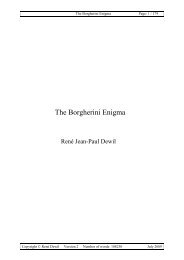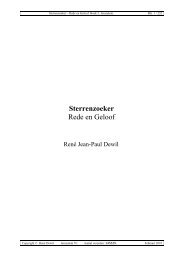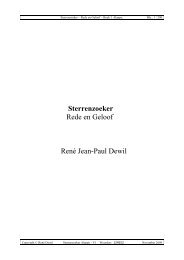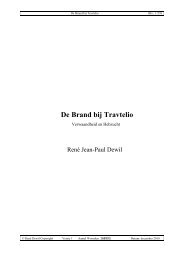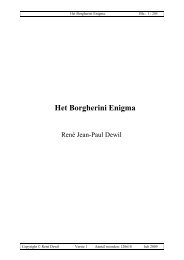A visual Journey into the Bible The Book of Genesis
A visual Journey into the Bible The Book of Genesis
A visual Journey into the Bible The Book of Genesis
You also want an ePaper? Increase the reach of your titles
YUMPU automatically turns print PDFs into web optimized ePapers that Google loves.
A Visual <strong>Journey</strong> <strong>into</strong> <strong>the</strong> <strong>Bible</strong> Page: 44<br />
<strong>The</strong>n all <strong>the</strong> springs burst and all sluices <strong>of</strong> heaven opened. It rained for forty days<br />
and forty nights. <strong>The</strong> ark lifted on <strong>the</strong> water and all human beings perished except <strong>the</strong><br />
ones in <strong>the</strong> ark. When <strong>the</strong> waters had subsided, Noah sent first a raven out, <strong>the</strong>n a<br />
dove but both returned to <strong>the</strong> ark since <strong>the</strong>re was no land to be found. After seven<br />
more days Noah again sent a dove. This one returned, holding in its beak a freshly<br />
picked olive leaf. When he sent <strong>the</strong> dove a second time, it did not return anymore.<br />
Noah looked out and saw that <strong>the</strong> surface <strong>of</strong> <strong>the</strong> earth was dry.<br />
Noah built an altar and burnt <strong>of</strong>ferings to God from <strong>the</strong> animals. God was pleased<br />
with this. He promised never again to curse <strong>the</strong> earth because <strong>of</strong> humans or to strike<br />
down living things again as he had done. <strong>The</strong>n God again established <strong>the</strong> covenant<br />
with Noah. As a sign <strong>of</strong> this covenant he put his bow – <strong>the</strong> rainbow – in <strong>the</strong> clouds.<br />
<strong>The</strong> <strong>Bible</strong> cites <strong>the</strong> descendants <strong>of</strong> Japheth, Ham and Shem, Noah’s sons. One <strong>of</strong><br />
Ham’s grandsons was Nimrud, who was <strong>the</strong> first potentate on earth. <strong>The</strong> <strong>Bible</strong> tells<br />
that Nimrud was ‘a mighty hunter in <strong>the</strong> eyes <strong>of</strong> Yahweh’. Nimrud’s empire contained<br />
Babel, Erech and Accad all in <strong>the</strong> land <strong>of</strong> Shinar. Later, Nimrud’s son Asshur built<br />
Nineveh and o<strong>the</strong>r cities. Of <strong>the</strong> cited cities one is quite well known by archaeologists.<br />
Erech was Uruk in Mesopotamia. Mesopotamia was Shinar, <strong>the</strong> land between and<br />
around <strong>the</strong> two rivers <strong>the</strong> Tigris and <strong>the</strong> Euphrates with <strong>the</strong> Euphrates on <strong>the</strong> West and<br />
<strong>the</strong> Tigris on <strong>the</strong> East. <strong>The</strong>se rivers drain <strong>the</strong> Zagros Mountains <strong>into</strong> a delta. Upstream<br />
<strong>of</strong> <strong>the</strong> junction <strong>of</strong> <strong>the</strong> two rivers stood <strong>the</strong> town <strong>of</strong> Uruk, now in ruins. <strong>The</strong> ruins <strong>of</strong><br />
Uruk were excavated and examined. <strong>The</strong> town consisted around 2500 BC <strong>of</strong> a few<br />
thousand houses surrounded by a broad wall. <strong>The</strong> town may have held between ten<br />
thousand to twenty thousand people. <strong>The</strong>re was a high ceremonial mound in <strong>the</strong> town<br />
on which stood ziggurats. In Uruk scribes wrote on clay tablets in a cuneiform script.<br />
About half a million <strong>of</strong> <strong>the</strong>se tablets were found, testifying <strong>of</strong> an intense economic<br />
and religious life.<br />
<strong>The</strong> <strong>Book</strong> <strong>of</strong> <strong>Genesis</strong> tells that <strong>the</strong> whole world <strong>of</strong> <strong>the</strong>se people still spoke <strong>the</strong> same<br />
language. In a valley <strong>of</strong> Shinar <strong>the</strong>y made bricks and baked <strong>the</strong>m in fire. <strong>The</strong>y told<br />
<strong>the</strong>mselves <strong>the</strong>y would build a city and a tower with his top reaching heaven. For<br />
mortar <strong>the</strong>y would use bitumen. God saw <strong>the</strong> city and tower and remarked that all <strong>the</strong><br />
undertakings <strong>of</strong> <strong>the</strong> people with a single language would succeed, nothing <strong>the</strong>y<br />
planned to do would be beyond <strong>the</strong>m. So he went down and confused <strong>the</strong> people and<br />
<strong>the</strong>ir language so that <strong>the</strong>y could not understand one ano<strong>the</strong>r anymore. Yahweh<br />
scattered <strong>the</strong>m all over <strong>the</strong> world and <strong>the</strong>y stopped building <strong>the</strong> city. That is why it<br />
was called Babel.<br />
Pieter Bruegel made two paintings <strong>of</strong> <strong>the</strong> tower <strong>of</strong> Babel. In <strong>the</strong> second one, now in<br />
<strong>the</strong> Kunsthistorisches Museum <strong>of</strong> Vienna. <strong>The</strong> tower is indeed surrounded by a town<br />
and Nimrud supervises <strong>the</strong> works. Bruegel had not seen <strong>the</strong> ziggurats <strong>of</strong> old<br />
Babylonia that <strong>the</strong> <strong>Bible</strong> writers must have had in mind. In Babylonia, ziggurats with<br />
temples on <strong>the</strong> top could reach hundred meters high and must have been indeed<br />
almost a world wonder for <strong>the</strong> humble Jewish shepherds. <strong>The</strong>se towers may have been<br />
called gates <strong>of</strong> <strong>the</strong> Gods or Bab-ili. <strong>The</strong> most ancient structure Bruegel recognised<br />
was Rome’s coliseum and that was probably <strong>the</strong> example he used. Like in <strong>the</strong> <strong>Bible</strong><br />
story, he showed <strong>the</strong> brick ovens and <strong>the</strong> tower reaching <strong>the</strong> clouds.<br />
Copyright ©: René Dewil Date: October, 24 2000



